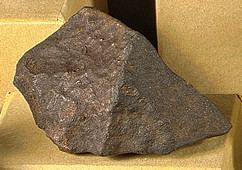Clan CM-CO Subgroup 3 | Group CO3.2 Shock stage 2 | |
 | ||
Fifteen pieces of the Kainsaz meteorite were seen to fall near Kainsaz, Muslyumovo, Tatarstan in 1937-09-13. The largest weighed 102.5 kilograms (226 lb), the total weight was ~200 kilograms (440 lb). As of January 2013 pieces were on sale for ~US$100/g. Kainsaz is the only observed fall in Tatarstan.
Contents
History
A fireball was observed which left a dust train and broke into fragments during flight in a series of detonations that were heard up to 130 kilometres (81 mi) away. The strewn field of 40 by 7 kilometres (24.9 mi × 4.3 mi) was oriented SE-NW with the largest stone falling at the NW end, the smallest (the size of a nut) near the village of Kosteevo at the SE end.
Mineralogy
Most of the chondrules (90 %) are either droplet (39 %) or lithic (61 %). The remaining 10 % are barred olivine, radial pyroxene, cryptocrystalline, glassy, sulfide-metal, micro-poikilitic and complex chondrules.
Classification
Kainsaz is classified as a CO3.2. This stands for CO group, petrologic type = 3, and subtype = 2. The group is part of the CM-CO clan and a member of the carbonaceous chondrites.
